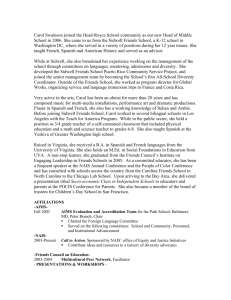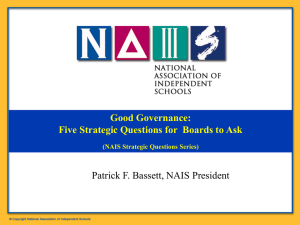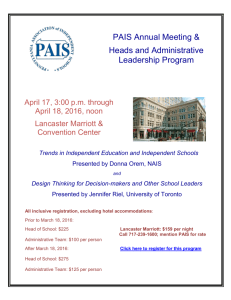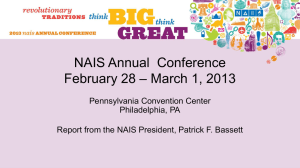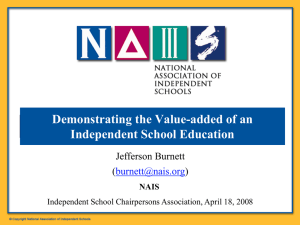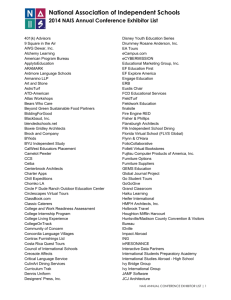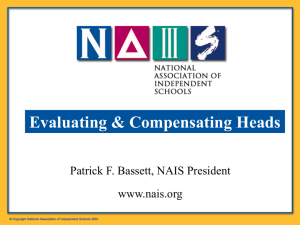Market Research: Measuring Alumni and Parent Attitudes
advertisement
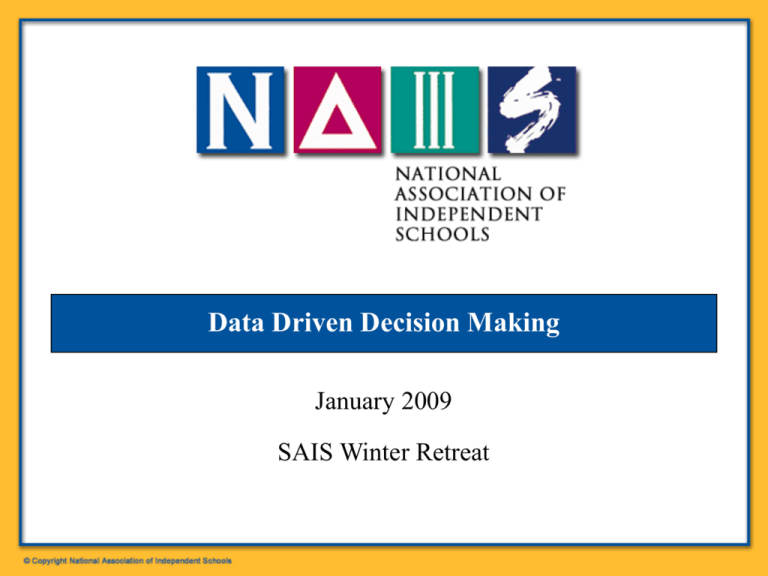
Data Driven Decision Making January 2009 SAIS Winter Retreat Part I The Value of Market Research Why Conduct Market Research? Market research: – Provides a systematic and objective method for collecting, analyzing, and using information for strategic planning and marketing – Enables you to know your constituents (parents, students, alumni) – Ensures that you are data-driven rather than anecdotedriven Market Research Keeps a School Strategically Focused What are our priorities? How well are we doing? What global, national, and local trends do we need to be aware of that might affect our school? Will local demographics sustain our school in the next 5-10 years? How do our constituents and the general marketplace view us? Where should we apply our financial resources? Market Research Informs Parent Surveys help to clarify: – – – – Why families choose a school How to best market a school to prospective families How satisfied current parents are with a school’s program Where a school is succeeding and where it needs to improve – What differentiates parents’ views of a school – How families experience a school’s culture Market Research Tells a Story Alumni Surveys aid in understanding: – The long-term benefits students gain from attending a school – Potential for alumni fund raising – How to best serve alumni today – How to connect with alums from different generations How to Conduct Market Research Identify what you need to know Establish a research agenda and calendar Determine the best, most cost-effective method of finding the information – Outside consultant or school staff? – Method? Focus groups, online survey, interviews, literature or research scan, telephone surveys, etc. Sample Market Research Agenda – Environmental Scanning (global, national, and local trends): Annually – Parent Research (satisfaction, why students enroll, priorities): Annually – Admissions Research (students who enroll and who do not enroll, attrition studies): Annually – Demographic Research (school-age population, family incomes): Twice yearly – Alumni Research (alumni planning and fund raising, alumni stats for marketing): Every few years – Image Assessment (community, current and prospective families, colleges): Every few years (From “The Value of Market Research” by Kathleen Hanson, Marketing Independent Schools in the 21st Century, NAIS, 2001. Part II Understanding Today’s Consumer What Trend Research Tells Us Current families are looking for specific data on value-added of independent education More choice in educational environment: public, charter, parochial, magnet, home-schooling Tuition is rising more quickly than disposable income in some parts of the country Changing Consumers: Gen X Parents Gen X parents with young children are most concerned about: Development and opportunity: emphasis on finding a school that offers a variety of activities and classes. They want schools to engage their children, and expose them to many things. Safety concerns: need to see that schools will keep their children safe from accidents, bullies, or other dangers. Too much selectivity, academic rigor, and standardized testing: concerned that putting too much pressure on their children will teach them to dislike school. – NAIS Special Population Research, April 2006 Changing Consumers: Parents of Older Children Parents with older children are most concerned about: Rigorous academics: look for middle and high schools that provide the necessary skills to prepare their children to be accepted into college and have a career – such as gifted programs and AP classes. Safety concerns: concerned about safety, but the issues are different and include social dangers such as drugs, gangs, and sex. NAIS Special Population Research, April 2006 Changing Consumers: African-American Parents African-American parents are most concerned about: Providing opportunity: say they want schools to open doors for their children and help them succeed in life. Economic and racial diversity: have practical concerns that their children will be isolated in majority Caucasian schools. Before and after school care: single parent and dual income families in all the groups say that before and after school care is important, but the sentiment is most concentrated in the AfricanAmerican groups. Standardized testing: are wary of standardized testing; they feel the tests are not always accurate representations of their children’s abilities. Religious affiliations: say they would prefer some religious influence in their children’s education. NAIS Special Population Research, April 2006 Changing Consumers: Hispanic Parents Hispanic parents are most concerned about: Rigorous academics: see a challenging curriculum as a key to better prepare their children for later life. Emphasis on moral values and community service: say that it is important for schools to support and supplement the moral values taught at home. Economic and racial diversity: would like their children to be in diverse schools, but not if it means lowering standards. Standardized testing: are also put off by an emphasis on standardized testing. NAIS Special Population Research, April 2006 Changing Consumers: Asian Parents Asian parents are most concerned about: Reputation of the school: think that a good reputation represents a composite of all the other factors they value such as rigorous academics, attentive teachers, etc. Allowing one’s child to be her/himself: want a school that helps their children develop in their own fashion; however, they do not want a school that allows lax discipline. NAIS Special Population Research, April 2006 Changing Consumers: On What They All Agree There are two principles that the parents in our research indicate they most want to find in schools for their children: nurturing critical thinking, intellectual, and personal growth; and attending to the child’s own particular needs. NAIS Special Population Research, April 2006 Changing Consumers: Why Some Won’t Choose Independent Schools Economic and racial diversity: say that independent schools are too often homogenous institutions. Real world experience: say that the lack of diversity in independent schools is a problem because it does not give their children “real world experience.” Elitism: say that independent schools, both institutionally and their student body, are insulated, elitist and condescending. NAIS Special Population Research, April 2006 Know your Audience Use the NAIS Demographic Center to stay abreast of changing family demographic data Learn which marketing channels and messages are appropriate for your various audiences Take advantage of NAIS Advocacy materials: www.nais.org Advocacy Home Page Part III Using National Research to Drive Marketing and Program Development Access National Research Studies HERI Reports: Independent Schools: Preparing Students for Achievement in College and Beyond NELS Reports:Values Added: The Lifelong Returns of an Independent School Education SAT Reports NAIS Parent Study NAIS Research Center: www.nais.org: Resources Major Focus of HERI Research Longitudinal study that charts normative data on the characteristics of students attending colleges and universities as freshmen. Explores – Attitudes – Habits – Aspirations HERI: Habits/Plans of College Freshman HERI: Freshman Community Involvement C o m m u n i t y HERI: Freshmen Community Involvement HERI: Freshmen Leisure Time Pursuits The Competitive Edge? % Perceive Above Average Independent Schools Public Magnet Schools Home Schoolers 67% 70% 69% Drive to Achieve 67% 72% 80% Leadership Ability 62% 61% Academic Ability 62% Source: HERI First College Year Survey The Competitive Edge? % Perceive Above Average Independent Schools Public Magnet Schools Home Schoolers Math Ability 41% 44% 34% Writing Ability 57% 54% 71% Public Speaking 43% Ability 40% 38% Source: HERI First College Year Survey Major Focus of NELS 2000 Research Study designed to track student outcomes over more than a decade. Followed students from eighth grade to beyond college, with focus on: – Postsecondary Education—degrees, aspirations, courses of study – Employment—work status, job satisfaction, computer use at work – Volunteer Service/Civic Duty—civic and community activities, voting record – Leisure Activities—reading, home computer use, physical fitness Educational Attainment Further Educational Aspirations Fields of Study: NELS Cohort/NAIS Alums Business/accounting—17.1% Health-related fields—12.1% Education—7.4% Liberal arts—7.2% Engineering—6.4% Liberal arts—12.9% History—7.9% Visual & Performing Arts— 7.6% Biological sciences—7.8% Psychology—6.8% Job Satisfaction In overall job satisfaction, 84.4% of the NELS cohort expressed contentment with their jobs, while a whopping 90.8% of the NAIS cohort expressed satisfaction Computer Use at Work Various Leisure Activities Part IV Conducting your Own Research Options for Conducting Your Own Research In-house research expertise Market research expert: local or national NAIS SurveyBuilder NAIS Demographic Center NAIS SurveyBuilder Standard Surveys w/customizable questions – – – – Parent Satisfaction Young Alumni Outcomes Board Assessment Head Evaluation Welcome Screen Create Survey Add Your Own Questions Conduct Demographic Research NAIS Demographic Center – Run reports on demographic changes by zip code/census track/block group – Study Metropolitan Area Reports for a summary of overall changes – Use Profile Analysis tool to pinpoint target recruitment areas The NAIS Demographic Center In November 2006, NAIS partnered with Easy Analytic Software, Inc. (EASI) to create the NAIS Demographic Center DEMOGRAPHIC CENTER Basic Reports 1. They include variables such as school population, families with children by income, race/ethnicity, and educational attainment 2. Types of reports: – – – Summary Reports Detailed Reports Multiple Area Reports DEMOGRAPHIC CENTER Additional Reports for Advanced Use 1. They include variables such as population, households, families, housing, income, employment, education, sales, cost of living, and/or consumer expenditures. 2. Five types of reports: – – – – – Quick Reports Ring Studies Quick Maps Rank Analysis Profile Analysis Study the Changes in School-age Population Part V Case Study: The Edmund Burke School—Using Research to Assess Market Potential What We Sought: Current Position in Marketplace What are Burke’s five- and ten-year admission trends? Yield trends? How do they compare with independent schools in the area? What is the image of Burke among DC region families? How could that be improved? Given the educational needs of Gen X families, what are Burke’s competitive strengths and weaknesses? Who are our parents today (e.g., by income range, race/ethnicity, public/private school orientation, financial aid history)? How price-sensitive are parents today? Do we have waiting lists today? If so, where? What We Sought: Affordability How are income demographics changing in the DC region? What is the elasticity of Burke’s tuition in the current market—at what price will we begin to lose families? At what price will we become unaffordable in the DC market? How does increasing tuition at our current rate affect our mission (i.e., how important is “affordability”)? Is our current financial aid model the correct one or should it look more like the college model in which most tuition is discounted? Our Research Agenda Study the admissions funnel (inquiries, applications, acceptances, enrollment) for Burke and similar schools in the marketplace to understand five- and ten-year trends for demand and yield. Conduct a parent satisfaction survey and review past parent satisfaction studies to assess satisfaction levels and to determine a profile of Burke families. Collect and analyze demographic data on growth of school-age children by zip code (those zips from which Burke currently draws students as well as those zips where there is the greatest growth in numbers). Collect and analyze demographic data on income growth for families with school-age children by zip code (those zips from which Burke currently draws students as well as those zips where there is the greatest growth in higher income families). Conduct a survey with area education consultants to identify changing trends overall and trends specific to Burke. And some closing thoughts on the value of acquiring new information… Every creative act involves a new innocence of perception liberated from the cataract of accepted belief. -Arthur Koestler Thank You! Donna Orem – Chief Operating Officer – NAIS – orem@nais.org
